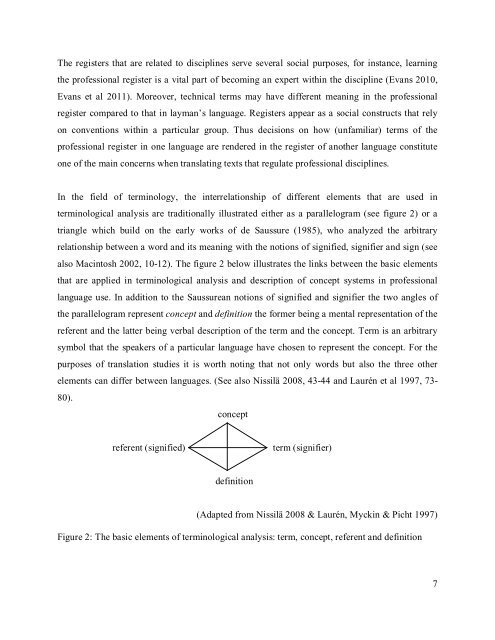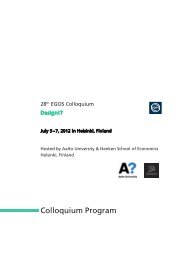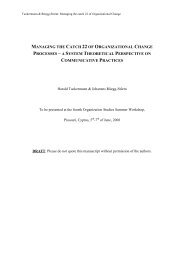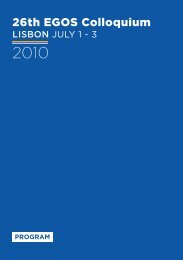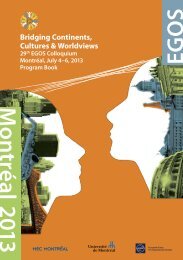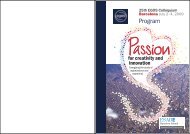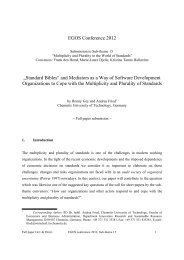A single set of standards and the multiplicity of interpretations - EGOS
A single set of standards and the multiplicity of interpretations - EGOS
A single set of standards and the multiplicity of interpretations - EGOS
You also want an ePaper? Increase the reach of your titles
YUMPU automatically turns print PDFs into web optimized ePapers that Google loves.
The registers that are related to disciplines serve several social purposes, for instance, learning<br />
<strong>the</strong> pr<strong>of</strong>essional register is a vital part <strong>of</strong> becoming an expert within <strong>the</strong> discipline (Evans 2010,<br />
Evans et al 2011). Moreover, technical terms may have different meaning in <strong>the</strong> pr<strong>of</strong>essional<br />
register compared to that in layman’s language. Registers appear as a social constructs that rely<br />
on conventions within a particular group. Thus decisions on how (unfamiliar) terms <strong>of</strong> <strong>the</strong><br />
pr<strong>of</strong>essional register in one language are rendered in <strong>the</strong> register <strong>of</strong> ano<strong>the</strong>r language constitute<br />
one <strong>of</strong> <strong>the</strong> main concerns when translating texts that regulate pr<strong>of</strong>essional disciplines.<br />
In <strong>the</strong> field <strong>of</strong> terminology, <strong>the</strong> interrelationship <strong>of</strong> different elements that are used in<br />
terminological analysis are traditionally illustrated ei<strong>the</strong>r as a parallelogram (see figure 2) or a<br />
triangle which build on <strong>the</strong> early works <strong>of</strong> de Saussure (1985), who analyzed <strong>the</strong> arbitrary<br />
relationship between a word <strong>and</strong> its meaning with <strong>the</strong> notions <strong>of</strong> signified, signifier <strong>and</strong> sign (see<br />
also Macintosh 2002, 10-12). The figure 2 below illustrates <strong>the</strong> links between <strong>the</strong> basic elements<br />
that are applied in terminological analysis <strong>and</strong> description <strong>of</strong> concept systems in pr<strong>of</strong>essional<br />
language use. In addition to <strong>the</strong> Saussurean notions <strong>of</strong> signified <strong>and</strong> signifier <strong>the</strong> two angles <strong>of</strong><br />
<strong>the</strong> parallelogram represent concept <strong>and</strong> definition <strong>the</strong> former being a mental representation <strong>of</strong> <strong>the</strong><br />
referent <strong>and</strong> <strong>the</strong> latter being verbal description <strong>of</strong> <strong>the</strong> term <strong>and</strong> <strong>the</strong> concept. Term is an arbitrary<br />
symbol that <strong>the</strong> speakers <strong>of</strong> a particular language have chosen to represent <strong>the</strong> concept. For <strong>the</strong><br />
purposes <strong>of</strong> translation studies it is worth noting that not only words but also <strong>the</strong> three o<strong>the</strong>r<br />
elements can differ between languages. (See also Nissilä 2008, 43-44 <strong>and</strong> Laurén et al 1997, 73-<br />
80).<br />
concept<br />
referent (signified)<br />
term (signifier)<br />
definition<br />
(Adapted from Nissilä 2008 & Laurén, Myckin & Picht 1997)<br />
Figure 2: The basic elements <strong>of</strong> terminological analysis: term, concept, referent <strong>and</strong> definition<br />
7


